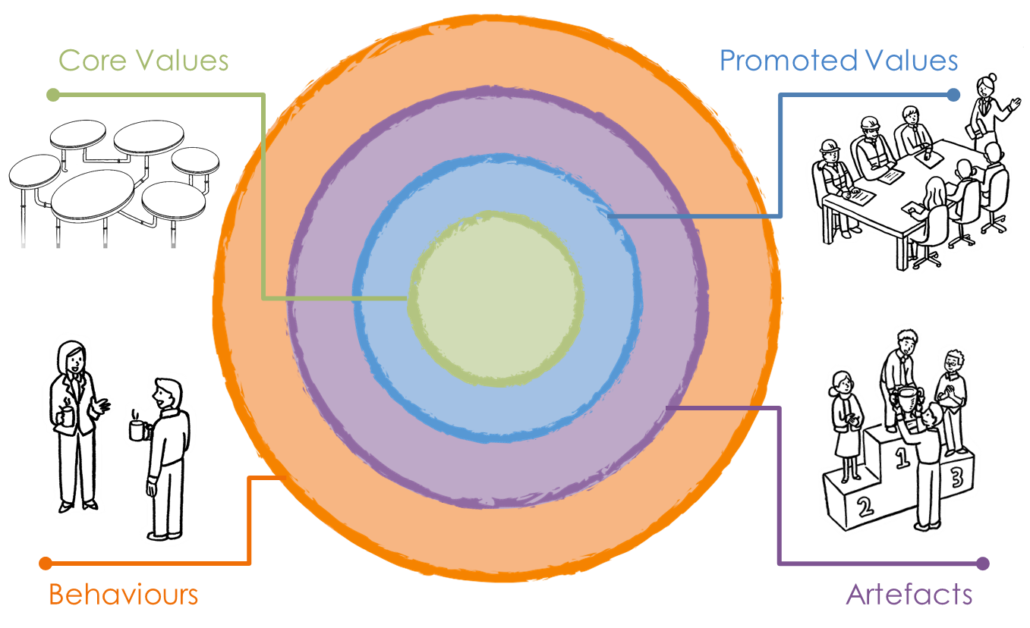




Culture Change Series #2: What Is Organisational Culture, and Why Does It Matter?
In the previous blog in this series we highlighted five reasons why organisations should pay more attention to culture in change initiatives. But what do we actually mean by culture – or, perhaps more usefully, how can we think about culture in a way that lets us address it?
So, culture – what is it?
Frankly, we’ve yet to come across a definition we really like. Some just plainly don’t seem to work: for example, ‘the set of processes in an organization that affects the total motivation of its people’. Are there some processes that don’t affect motivation one way or the other? Is culture really reducible to processes – so that identical processes would drive identical cultures in different organisations? We don’t think so.
Other definitions seem to get closer: ‘Culture is the organization’s immune system’ and ‘Culture is how organizations ‘do things’’ say Michael Watkins and Robbie Katanga respectively. The idea of toxic organisational culture as an auto-immune disease is attractive, but cultural immunologies and immunologists seem few and far between. And, what are the metrics for ‘how’ organisations ‘do things’: does that actually come down to fine levels of ‘what’ organisations do, in any case?
The quest for a definition that satisfies ultimately seems misguided. At Afiniti we agree that culture is something to do with the ‘feel’ of an organisation, underpinning the motivations of its people and ultimately the performance of the business. We concluded that it was more important to know how to ‘shift’ a particular culture than to be able to define organisational culture per se. We looked around for models, and in Edgar Schien’s work, and in its application by other organisations, we found something that resonated and offered real potential as an actionable framework.
In summary, we’re working with a framework of four interacting levers:
- Core values: these are the mostly unconscious, taken-for-granted beliefs and assumptions at the heart of the organisation’s culture.
- Promoted values: in contrast, these are the values an organisation claims to hold or temporarily promotes, but which have not yet truly become a part of its culture. We think of these as descriptions of how the organisation wants to be.
- Artefacts: these are what we can observe – including organisational structures, processes and systems, office layout, dress codes, status symbols, rewards and recognition. As such, artefacts make a culture tangible.
- Behaviours: these are not as visible as artefacts, but nevertheless are observable. As ‘the way we do things around here’, they both demonstrate and re-inforce an organisation’s culture. When modelled by leaders and other influencers they can establish new norms.
The little things leaders do have far more impact than the big things they say.
The four ‘levers’ need to work together
Core values can develop and change slowly over time, but if promoted values are in serious conflict with them, a culture change initiative will almost certainly run into the sand. If values are promoted in isolation of artefacts and behaviours they will become ‘shelfware’. Changes to artefacts or behaviours with no aligned and explanatory promoted values can seem random and will confuse. And if visible behaviours (especially leadership behaviours at all levels) don’t change to align with promoted values, then nobody will take the intended change seriously. One of our mantras is that the little things leaders do have far more impact than the big things they say.
The advice we give to our clients is that to shift a culture means working with all four levers: recognising core values, and integrating activity involving the other three.
The final blog in this series will unpack some of the ‘how’ of working with the levers.
As ever, we’d love to hear from you with your thoughts and experiences around the topics covered here, so send us a comment or an email – we’re always ready to talk ‘business change’!
To get the latest change tips, advice and guidance directly to your inbox, sign up to our monthly Business Change Digest.

